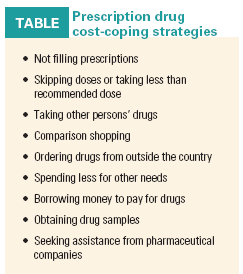Clinical trial patients cope well with prescription drug fees-for the time being
ORLANDO-The ancillary treatment costs of managing side effects can be burdensome to patients, so Harvard Medical School investigators were somewhat surprised when clinical trial patients reported little anxiety about paying for these drugs. But as more people become uninsured or underinsured, and the costs of drugs rise, patient anxiety could increase and adherence to treatment diminish, the lead author predicted.
ABSTRACT: Few participants felt the need to adopt cost-coping strategies to pay for supportive drugs, according to a study presented at ASCO 2009.
ORLANDO-The ancillary treatment costs of managing side effects can be burdensome to patients, so Harvard Medical School investigators were somewhat surprised when clinical trial patients reported little anxiety about paying for these drugs. But as more people become uninsured or underinsured, and the costs of drugs rise, patient anxiety could increase and adherence to treatment diminish, the lead author predicted.

Only one in 10 patients in the study said they worry about paying for supportive medications. But even when cost was a concern, patients rarely discussed the cost of prescription drugs with their physicians, reported Deborah Schrag, MD, MPH, associate professor of medicine at the Boston-based school and the Dana-Farber Cancer Institute.
“Supportive care medications, such as anti-emetics, can be very expensive, and not all patients have prescription drug coverage. If patients do not take supportive medications, they may have more toxicity, which may prevent them from receiving optimal chemotherapy,” Dr. Schrag said at an ASCO 2009 press conference. “We began our study when Medicare Part D was initiated, to see how patients were coping with prescription drug costs.”
The study was a companion analysis to the CALGB 80405 phase III trial evaluating bevacizumab (Avastin) and cetuximab (Erbitux) for metastatic colorectal cancer. The investigators interviewed 409 patients at baseline regarding their previous use of cost-savings strategies (see Table on page 14), and three months after starting treatment to determine how they were coping with paying for anti-emetics, antibiotics, antihypertensives, and so forth while on the trial (abstract 9503).
While 45% of patients said they had used more than one coping strategy to pay for prescription drugs in the past, this number was not affected by starting chemotherapy. In fact, at three months, only 19% reported using more than one strategy to pay for drugs. In other words, only a small minority newly adopted a strategy to lessen the cost burden after starting chemotherapy on the trial, Dr. Schrag reported.
Other key findings:
• 39% were taking five or more prescription drugs three months after starting chemotherapy.
• 10% of patients were very worried about paying for prescription medications.
• 15% did not have prescription drug coverage and were more likely to use money-saving strategies.
• 12% reported discussing the cost of medications with their physicians.
Use of specific coping strategies at the three-month follow-up was low: 7% did not fill prescriptions, 3% took less than the recommended dose, 14% obtained samples, 1% sought drug company assistance, 9% spent less on basics, and 7% borrowed money to pay for their drugs.

“We were pleased to find that most clinical trial participants did not encounter hardship,” Dr. Schrag said. “It is possible that patients treated outside the context of a research study may have a harder time affording supportive care medications. When chemotherapy regimens are proven effective in trials, then are rolled out for widespread use, the potential for toxicity increases if patients are less able than the trial population to cope with the costs of supportive care.” This could explain some of the differences in clinical outcomes observed in clinical trials vs community settings, she said.
Dr. Schrag also highlighted the need for oncologists and patients to broach the issue of cost, particularly in the current economic climate. “Oncologists may wish to discuss access to drug coverage prior to embarking on a course of chemotherapy,” she suggested.
Targeted Therapy First Strategy Reduces Need for Chemotherapy in Newly Diagnosed LBCL
December 7th 2025Lenalidomide, tafasitamab, rituximab, and acalabrutinib alone may allow 57% of patients with newly diagnosed LBCL to receive less than the standard number of chemotherapy cycles without compromising curative potential.